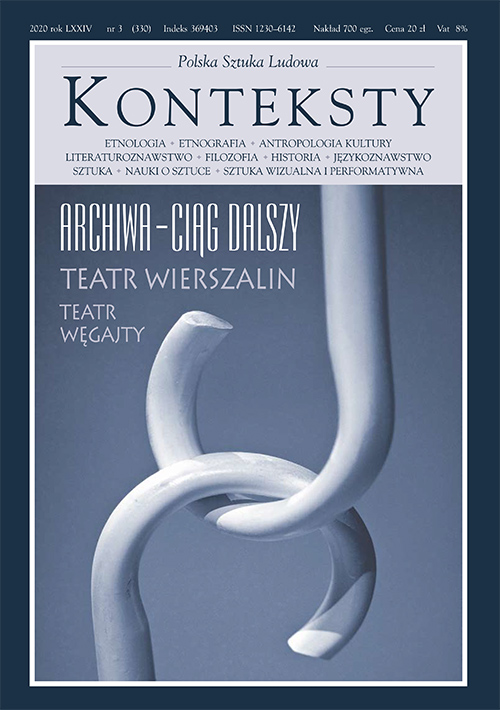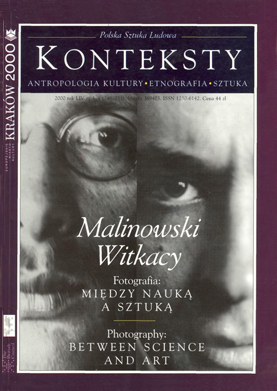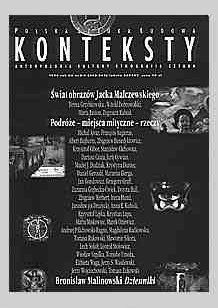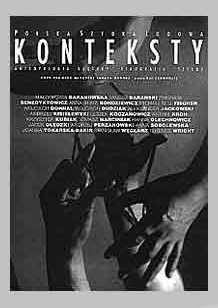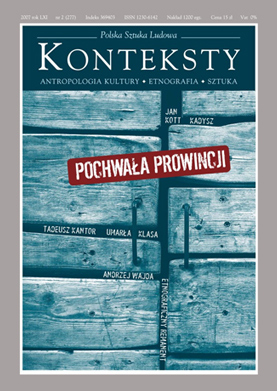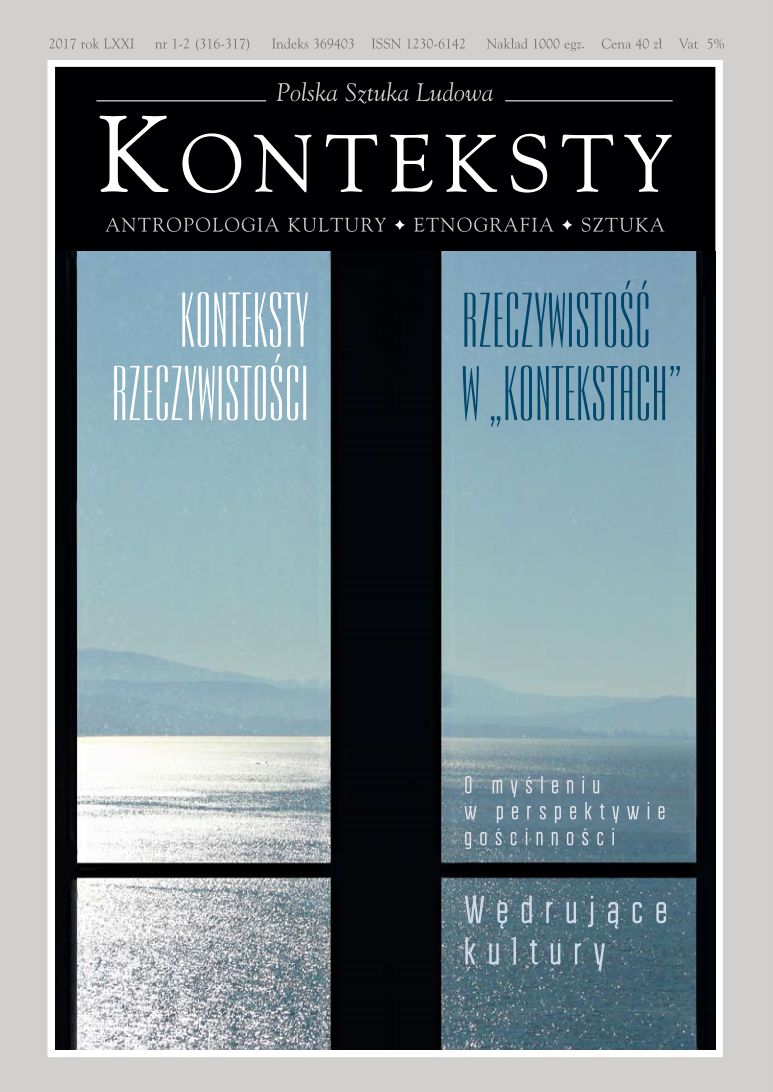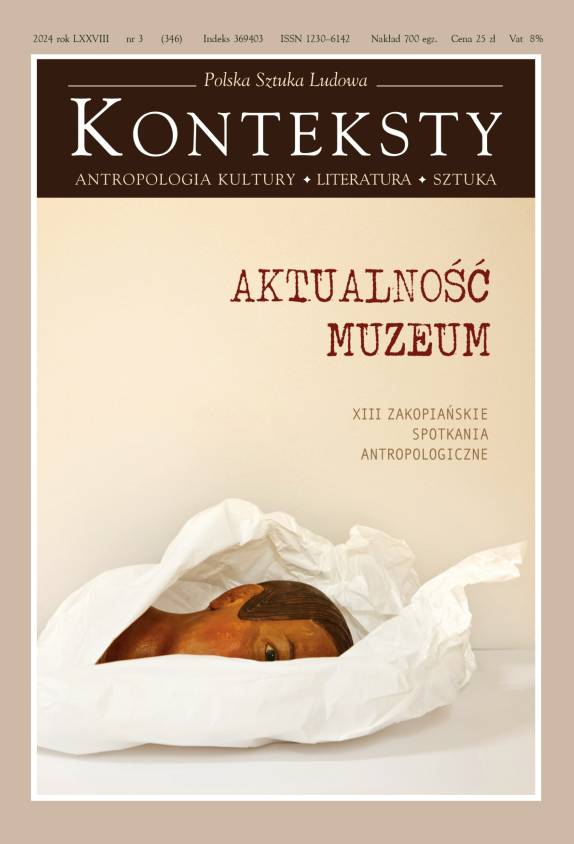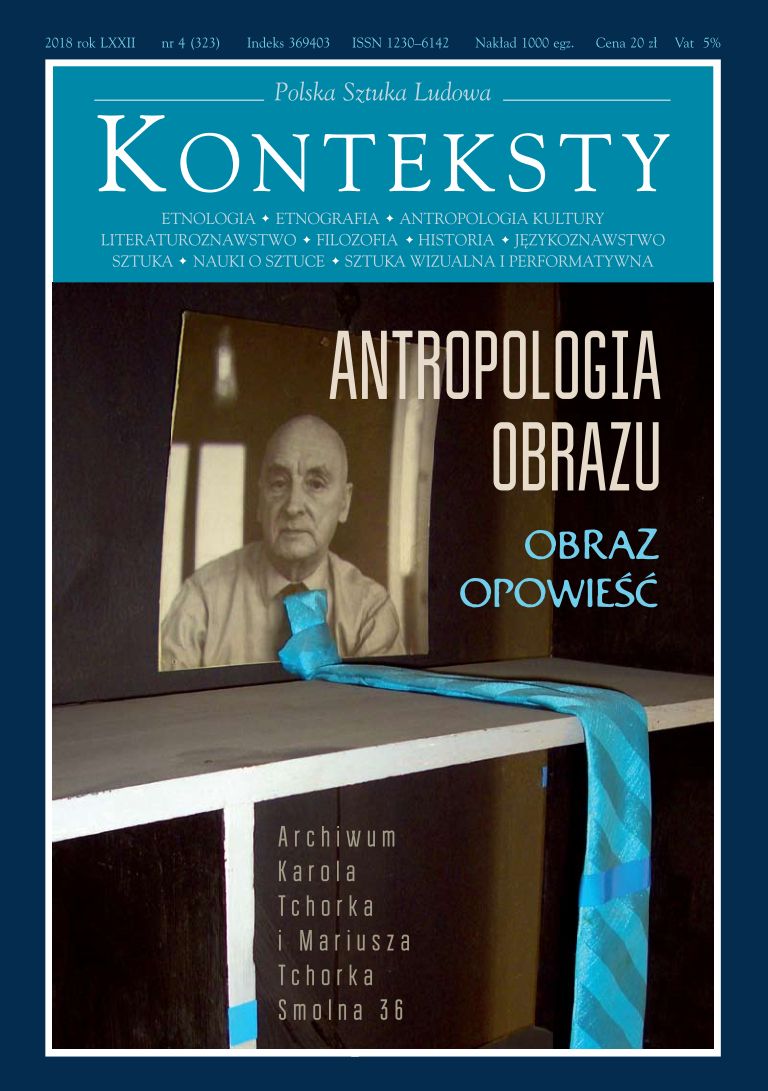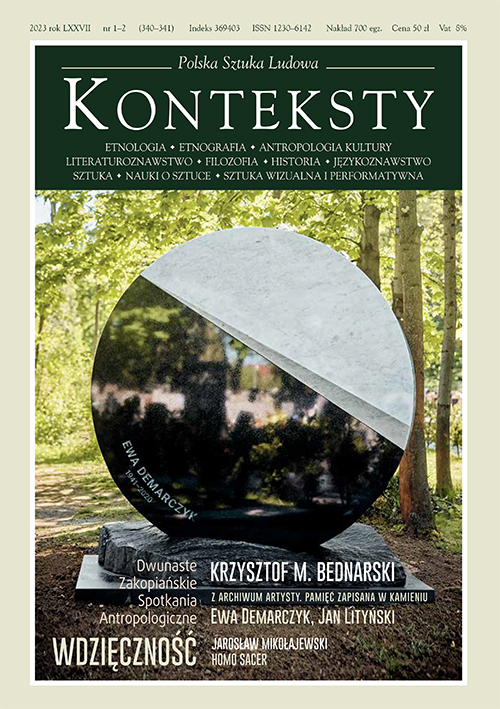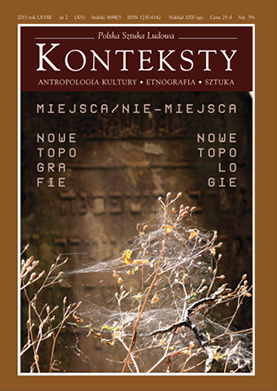Issue 2007/1 (276) - We have 60 years!

| Zbigniew Benedyktowicz | 2 | |
| Bartłomiej Walczak | Paul Stoller’s Project of Eidetic Ethnography  | 5 |
A presentation of the controversial In Sorcery’s Shadow by Paul Stoller and Cheryl Olkes – a record of Stoller’s experiences with the Songhay in Niger . The author of this review formulated the thesis that Stoller’s mimetic involvement in sorcery and the resultant strong emotive (and psychosomatic) reaction are the consequence of an attempt at realising a programme of eidetic (phenomenological) ethnography, outlined in his previous texts. The experiences registered by Stoller are analysed with the assistance of the conception of triple mimesis (Paul Ricoeur) and instruments applied for text analysis. Regardless of the dramaturgy of the experience itself, the case of Paul Stoller is an excellent contribution to reflections on the boundary of cognition in anthropology, and the translatability of perspectives between distinct varieties of Lebenswalt. The dramatic history of the author of Money Has No Smell demonstrates that an attempt at a total opening up towards local cognitive categories, the detextualisation of culture, and the assumption of ”the skin” of the Other may end in a significant deprecation of research objectives and a mimetic merge of two identities. The text is partly based on chapter V of the Ph. D. dissertation Podmiot a przedmiot poznania nauk społecznych na przykładzie antropologii kulturowej. Analiza wybranych struktur narracyjnych w pisarstwie antropologicznym (The Subject and the Object of Cognition in the Social Sciences upon the Example of Cultural Anthropology. An Analysis of Selected Narration Structures in Anthropological Writings), presented in 2006 in the Institute of Applied Social Sciences at Warsaw University . | ||
| Agnieszka Karpowicz | The Collage Experiment. The Leopold Buczkowski Archive  | 17 |
The ”ephemera of memory” comprise a category constitutive for the works of Leopold Buczkowski. Punctualistic, aleatoric non-fiction constructions create museum space in which the author tries to revive ”Rusin words-sounds”, i.e. the living, dialogical and multicultural vernacular of pre-war Podolia. His stories, however, progress more in time than in space by creating simultaneously overlapping strata of myriad versions of events, myths, and imagery, enrooted in collective imagination. The homophonic quality of the ephemera corresponds to the fleeting nature of human memory. With attempts at capturing living speech and music as his point of departure, Buczkowski arrived at decontextualised records or even written down conversation when, for instance, he creates narration composed of quotations from Polish-French phrase-books. Only decontextualisation, characteristic for the written word, is regarded by the author as a tool suitable for building a memory museum; he thus endeavours to create an archive of forms no longer existent after the Second World War, in this way salvaging a dying world and chronotypes doomed to oblivion. By setting up an archive of past forms of culture and art Buczkowski also conducts an in-depth analysis of modern culture based on the bourgeois ethos and writings which he holds responsible for the catastrophe of the Second World War. In the ”museum of memory” writing has assumed the shape of archaeology, i.e. the extraction of the relics and forms of a vanishing world from oblivion. This is the reason why narration brings to mind a collection. It remains specific because its medium is the printed word. Just as in collections of objects, it constitutes an attempt at reaching, via material (here: the letter, the visible sign of writing), that which is invisible and impalpable – forms of a world which perished in World War II. The instruments applied by the author are close to the techniques of twentieth-century art which also frequently turns into archaeology by gathering actual objects and the debris of contemporary civilisation. Prose by Buczkowski resembles a visual art collage, an assemblage executed with the help of the recycling technique. | ||
| Jacek Leociak | Contemporary Antigone  | 41 |
One the determinant of humanity mentioned by Giambatisto Vico is burial of the dead. The author of this study does not deliberate on burial conceived as attempts at taming dread of the deceased or an act stemming from fear of the impurity of the corpse. He is interested in testimonies describing situations in which the human corpse is defiled and the burial ritual – violated, as well as in attempts at restoring the thus undermined order of things. Subsequently, he ponders on the nature of interment in extreme situations (such as the world wars or the Holocaust) and the cultural meanings borne by the act of defiling the corpse and desacralising the burial ground. The article starts with recalling classical tradition (Homer, Sophocles, Virgil, and the Bible) and goes on to study records from the Warsaw ghetto (primarily those by Rachela Auerbach). In doing so the author focuses on burial comprehended as the obligation of the living towards those who were not allowed to survive. In this context, efforts to fulfil the burial ritual should be understood as a final protection of the foundations of humanity at the time of Shoah. | ||
| Paweł Stangret | A Concise History of the Avantgarde in Tadeusz Kantor’s Lekcje mediolańskie  | 55 |
The article considers the presence of the avantgarde in the oeuvre of Tadeusz Kantor, and tries to capture the artist’s conceptions relating to contemporary art. The helpfulness of Lekcje mediolańskie (The Milan Lessons) lies in the fact that this publication is situated on a margin of Kantor’s theoretical reflections and artistic undertakings. The text shows how abstraction, Constructivism and Surrealism affected the work of the author of Umarła klasa (Dead Class). Lekcje mediolańskie also indicates the reasons why Kantor referred to precisely those three trends, summing up their role and significance in twentieth-century art. Kantor returned to the bases of modern art in order to define his whole oeuvre and contemporaneity as such vis a vis the listed currents. | ||
| Aleksandra Melbechowska-Luty | Elegy and Drama. The Niches, Passages and Thresholds of Jacek Sempoliński  | 65 |
In March 2006 the Studio Gallery in Warsaw held an exhibition of paintings and drawings by Jack Sempoliński, testifying to the considerable extent in which his oeuvre is connected with the ingenium of Kazimierz on the Vistula , an exceptionally picturesque small town whose symbolic, myth and legend have successively grown in the course of past centuries. Sempoliński used to come here already as a child, and from 1979 he spends his summer vacations in an old thatched-roof cottage in nearby Męćmierz. The show featured numerous ”Kazimierz” works (executed in mixed techniques) in which objects and motifs change into sui generis phenomena of spiritual art, functioning on a lower level and living a life of their own. The works in question include a Baroque statue of St. John from the parish church, transposed by the artist, The Crucified from the church of St. Anne, dramatic Heads of the dying Christ, simple crosses without the figure of Jesus, executed in pencil, water paint or pastel, the local quarry with outlines of blocks of stone, the shadow of a cross or a skull, as well as views of the castle in Janowiec, a metaphor of the author’s recollections and youthful experiences. | ||
| Aleksander Jackowski | Jerzy Jarnuszkiewicz  | 71 |
In this fragment of a book currently in print, Aleksander Jackowski reminisces about the outstanding sculptor Jerzy Jarnuszkiewicz, recalling the post-war years, the 1950s and the 1960s in the artist’s oeuvre. This period certainly differed from the contemporary conditions of Polish art ”His era required memory and forced the artist to tackle the setting of lies and the gag of censorship. Today, young artists are free of such determinants and feel no need to commemorate anything. The world of their imagination is open. They astonish and even shock, without having to paying any price for doing so (...) Could a portrait of an artist, even such an acclaimed one, be of any interest at a time when all the components of art are changing, and when it has become outright embarrassing to speak about the categories of beauty and consider what which is ethical (...)?” The proposed text is also an attempt at personal meditation on memory: ”We live in such rapid times that unrecorded memory vanishes instantly. Art? Everyday there appear more painters and sculptors than in the whole history of mankind. The rushing tide of facts is simply enormous. Which young intelligent person today knows anything about Tadeusz Sieklucki, Tadeusz Brzozowski, Józef Gielniak or Jerzy Panek? About the great artists? What are you working on at the moment? – I was asked by a female journalist from an important daily. – I’m writing about Jarnuszkiewicz... – And who’s he? Well, I am writing so that she would know”. | ||
| Wojciech Bałus | 99 | |
| Aleksandra Melbechowska-Luty | Tribal Rhapsody. Private Notes on the Art of Magdalena Abakanowicz  | 105 |
The numerous sculptures by Magdalena Abakanowicz (and her examples of related arts) include unusual visual concepts, meanings and contents relating to man’s individual and group experiences. Abakanowicz is interested in all that is alive: man, animal and plant, their diverse” bodies”, which she shapes or commemorates in anthropomorphic or biomorphic forms by using natural material, e. g. wool, canvas, jute, hide, horsehair, and wood but also stone and metal. The characteristic features of her works include monumentalism and a masterly treatment of ”mobile” textures which link the structures of the surface with the very core of a given composition. Abakanowicz is the author of highly unconventional fabrics known as Abakany; these by no means decorative or utilitarian objects comprise large-scale soft sculptures organizing space. She finds the thread which ties together the structure of living organisms to be fascinating material. The human figures which are, as a rule, incomplete, maimed, naked, headless, armless, and sexually undefined (derived from the myth of Androgyne), are accompanied by Sitting Figures, Backs, Heads, Faces, Self-portraits and the figures and heads of animals. Hundreds of figures – swathed in sacking or cast in bronze – are arranged in rows and crowds against the backdrop of a panorama of large towns, in parks and gardens or on the banks of rivers and lakes. These “collective” compositions carry universal symbolic messages and speak about ”primary things” extracted from the depths of time; simultaneously, they are transposed into contemporary life and evoke a metaphorical image of the endless ”migration of the peoples”. Abakanowicz constantly resorts to the oldest motifs, such as the form of the circle. She executes round spoke constructions and rolled bearings, and in Israel arranges large circles composed of limestone in the Negev Desert. She also embarks upon the catharsis motif and depicts perennial War Games involving wounded human bodies and war machinery – guns and missiles, resembling toppled trees. Her Sarcophagi bring to mind coffins and the covers of nuclear reactors. Untamed imagination directs her towards architectural- town planning sculpture designed on an immense scale. Abakanowicz is the author of visions of plant-entwined houses-gardens intended for Paris and the 640-metres high Hand Monument, probably the loftiest statue in the world, stretched towards the sky and commemorating the victims of Hiroshima. Her entire oeuvre refers to the existential and spiritual condition of homo universalis and all cultures, at the same time becoming part of the ”correspondence of the arts” since the compositions resound with the echoes of musical rhythm or correspond to the visions of poets (T. S. Eliot) and architects (Hand Monument evokes the conception launched by Le Corbusier who half a century earlier executed a sculpture of The Open Hand raised towards the heavens in the Indian town of Chandigarh). | ||
| Bernd Stieghorst | 110 | |
| Teresa Ryf Esbert | 111 | |
| Joanna M. Sosnowska | An Old Female Artist Paints  | 112 |
Only recently has old age become the object of reflections pursued in assorted domains of science. Indubitably, the reason for this phenomenon lies in constantly expanding longevity. We still do not have at our disposal criteria for determining the precise onset of old age, and prevailing opinions remain at odds. As a rule, it is accepted that old age is tantamount to maturity when spiritual issues predominate over material ones, particularly corporeal. Marcel Proust was an exponent of a contrary view claiming that the commencement of old age is marked by a changed attitude towards the surrounding world, when bodily relations, to use the expression coined by the writer, become more important than spiritual ones. This is the moment when contact with the object, the landscape and another person assumes a new significance, and becomes a nourishment of sorts, indispensable for life and creativity. Późna twórczość wielkich artystów (The Late Works of Great Artists), a book by Mieczysław Wallis published more than thirty years ago and devoted predominantly to aged artists – albeit not exclusively, since the very term ”late works” does not have to denote creativity dating from an artist’s old age, makes no mention of female artists as if the very problem did not pertain to them. From a statistical viewpoint, for centuries women tended to die earlier than men, but this was not the essential reason for the omission. The explanation should be sought in the category of womanhood obligatory in our culture. Only a woman capable of fulfilling maternal functions was regarded as noteworthy. An old woman who had already completed all her duties towards the family and society, became a matron and was accepted only in this guise. Apparently, the combined status of a matron and an artist was excluded. Those two social constructions could not be mixed, and female artists were refused the right to have a family; for all practical purposes old female artists did not exist. Nevertheless, there always remained the sort of a woman who violated the imposed rules of conduct, and frequently she was an artist. Already in her youth Olga Boznańska rejected the demands of the patriarchal world and did not accept the functions deemed fitting for a woman by totally devoting herself to art. By refuting all subjugation to conventions, in time she drew attention to something which usually remains invisible, i.e. otherness attained by age itself. As an older woman she fascinated the visitors who appeared in her rather unkempt studio. Physical relations, understood as contact with objects and people, remained extremely important due to the very fact that she was a painter, and with age they grew even more intense. She needed them in the same manner as the one described by Proust, succumbing to the tide of life delineated by old age. | ||
| Wojciech Bałus | Dan Brown, his Macho and the Question of Truth  | 121 |
In his critical comments about Dan Brown’s bestsellers, W. Bałus, an historian of art, omits their widely commented factographic preposterousness and focuses on the measures applied by the novelist in order to construct the leading protagonist as well as the latter’s conceptions about culture. Robert Langdon, the hero of Brown’s books, appears to be a scientific macho and an advocate of scientism, whose knowledge possesses all the traits of total unambiguity akin to nineteenth- century visions of culture. Brown is described as yet another ”master of suspicions”, and his book is regarded as a successive example of postmodern para-religious nonsense. | ||
| Artur Rumpel | Pious Inscriptions in the Tworki Deanery  | 123 |
Folk songs are suffused with symbolic, in the past universally understood and today largely forgotten. Almost every song had not a single meaning but at least two or even more. At present it has become impossible to discover all of them although in certain cases such an objective may be attained. The presented song Miała Kasia Jasia (Kate and her Johnny) describes the tragic death of a young man on the battlefield and the complicated love for a poor boy, disclosed by a sequence of legible symbols which create a logical whole. | ||
| Czesław Robotycki | Against Kopaliński and towards Bartmiński. On a Polish Dictionary of Folk Stereotypes and Symbols  | 129 |
The title of the article suggests a cautious use of dictionaries of catalogue-arranged symbols in all interpretations of culture (in Poland the author of the most popular dictionary of this sort is W. Kopaliński). C. Robotycki claims that the anthropologist will find ethno-linguistic dictionaries of greater use. Dictionaries of symbols list meanings without indicating their pragmatic context, while the latter variety locates symbolic meanings within the context of the vocabulary, grammar and pragmatic rules. Such a dictionary has been written by Jerzy Bartmiński (together with a team of collaborators). The range of this publication encompasses folk symbols and linguistic stereotypes, making it possible to reconstruct the linguistic image of the world of culture. The author discusses the premises of the presented dictionary and the manner of their realisation; he also emphasises the importance of links between ethno-linguistic and anthropological reflections, indicating the long tradition of ethno-linguistics derived from the philosophy of the language, anthropology and linguistic studies. | ||
| Jerzy Bartmiński | 135 | |
| Dorota Piekarczyk, Joanna Szadura | 136 | |
| Aleksander Jackowski | “Na Skróty”. Postscript  | 148 |
A postscript to the autobiographical Na Skróty (Shortcuts) by the long-term editor-in-chief of ”Polska Sztuka Ludowa” and a steady collaborator of the quarterly ”Konteksty”; the book was published several years ago. | ||
| Marek Nowakowski | 160 | |
| Marek Nowakowski | 162 | |
| Joanna Pietruszka | On Those who Stayed Behind. A Study on Old Age and the Looming Extinction of the Ukrainian Countryside  | 164 |
A presentation of old age along the borderline between contemporary society and a Ukrainian traditional rural community facing extinction. The portrayed group of people share their place of residence, age, and experiences of historical events as well as the progressing disappearance of village life. Upon the basis of a local comprehension of the conception of age – within the context of performed social roles and health, the author interprets the organisation of life and the changes transpiring within the community. Observations of daily life, communication and memory of the deceased serve as a foundation for describing strivings towards the maintenance of a continuum and resistance against the gradual loss of impact on one’s fate. | ||
| Justyna Chmielewska | An Old Story of New Jerusalem  | 171 |
An attempted reconstruction of the history of the Murashkovtsy Christian Holy Zionists – a religious community established in the 1930s in present-day Western Belarus and Ukraine. The chief protagonists are the prophets Ivan Murashko and Olga Kirylchuk-Korneychuk who, according to the Zionists, embodied the Second Coming of Christ. By basing herself on on-the-spot interviews the author tried to bring the reader closer to hagiographic narrations about the miracles and sanctity of the Father and Mother of Zion, as the founders of the movement were known, and the history of New Jerusalem – a holy city built in 1936–39 in Volhynia as a realisation of the idea of the Kingdom of God on Earth. We learn about prophets, apostles, holy blood and New Zion as well as about rejection and strong social stigmatisation. The post-war history of the group is branded with persecution, arrests and imposed wanderings from Volhynia across the Caucasus to Central Asia and finally to the environs of Odessa where more than 350 members of the congregation continue to reside. From the very onset the Zionists, engaged in implementing their utopia, remained on the margin of social and religious life. Ridiculed by some and openly branded by others, they sought refuge in isolation, fled the outside world, and closed themselves in enclaves governed by rules formulated by the prophets. The presented text is an attempt at bringing the reader close to the alternative created by the Murashko adherents in their New Jerusalem. | ||
| Wiesław Szpilka | No So Long Ago  | 183 |
In 1981 ”Polska Sztuka Ludowa” published a survey on Ethnography – ethnology – anthropology of culture. What are they? What is their objective? The survey was a sui generis generation manifesto issued by researchers connected with the editorial board of ”Polska Sztuka Ludowa” (today: ”Konteksty”), who at the time perceived ethnography as a ”science without boundaries” and one which ”opts for freedom”. This methodological breakthrough (which coincided with the proclamation of martial law) became the reason why, according to the author of the article, Polish ethnography lost its innocence. The presented text, written in the form of a recollection, challenges oblivion. Józef Czapski wrote that ”personal reminiscences rebel against the reduction of our past, which has been already pigeonholed by historians and devoured by statistics and figures in the order of millions to become abstract and almost meaningless for the next generation”. | ||
| Krzysztof Bielawski | 186 | |






